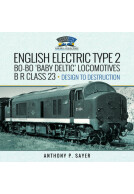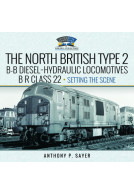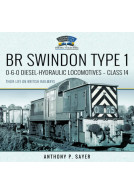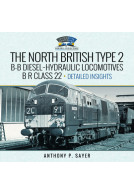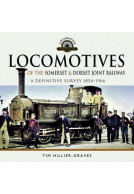The B T H and North British Type 1 Bo-Bo Diesel-Electric Locomotives - British Railways Classes 15 and 16 (Hardback)
Development, Design and Demise
Imprint: Pen & Sword Transport
Series: Locomotive Portfolios: Diesel and Electric
Pages: 352
Illustrations: 150 colour and black and white illustrations & weight diagrams
ISBN: 9781526761965
Published: 16th November 2021
(click here for international delivery rates)
Need a currency converter? Check XE.com for live rates
| Other formats available - Buy the Hardback and get the eBook for £1.99! | Price |
|---|---|
| The B T H and North British Type… ePub (46.6 MB) Add to Basket | £19.99 |
The British Railways ‘Pilot Scheme’ orders of 1955 included ten BTH and ten NBL Type 1 locomotives, these being introduced during 1957-61 for use in East London, and on the Great Eastern and London, Tilbury & Southend lines. The BTH fleet subsequently expanded to forty-four, as a consequence of their light axle-loading and the availability of spare manufacturing capacity which BR chose to exploit in their quest to eliminate steam traction.
Further construction of these two classes ceased after the fifty-four units, with preference being given to the highly reliable English Electric product which by mid-1962 had proliferated to 128 examples.
The NBL fleet survived until 1968, being withdrawn after ten years of indifferent performance. The BTH locomotives followed by 1971, although four lingered on as carriage pre-heating units. Dramatic reductions in goods traffic during the 1960s/70s particularly impacted local trip and transfer freight duties, the ‘bread and butter’ work for the Type 1s, and it was inevitable that the less successful classes were retired from traffic first.
This book looks at the short history of these two classes, making extensive use of archive sources, combined with the primary observations of numerous enthusiasts. Previously unpublished information, covering the introduction, appearance design and performance issues of the locomotives, form a central focus, and, allocations, works histories, storage and disposals, liveries and detail differences are covered in the same level of detail as previous volumes in the ‘Locomotive Portfolio” series.
In summary, this volume is probably the most comprehensive account of these classes that one could wish for.
Rail Advert
4.9 out of 5
Read the Full Review Here
Anthony P Sayer has produced another cracking volume in Pen & Sword’s Locomotive Portfolio series, this time covering two small classes of diesel traction designed as part of the Pilot Scheme orders of 1955. It follows the same format as earlier volumes, with a huge amount of detail in its 350 pages on how the locos came to be built, their technical specifications, individual histories of each member of the two classes, and illustrations of each member of the classes at various stages of their short lives. At least one photo of each class member is provided, together with depot allocations and withdrawal dates.
Barney Forsdike
As with previous volumes in this series, a huge amount of research time was clearly invested in the book, and one of the highlights is the author’s access to and quotes from official archive records such as those involving BR and manufacturers’ representatives dealing with the early loco failures in traffic. We read of fractured crankcases, distorted cylinder heads and blocked turbochargers, but it is also clear from BR records that the BTH design had a significantly higher availability than its North British counterpart. Once again, questions arose during the 1960s over whether the cost of significant alterations to components could be justified in the light of declining traffic and the anticipated short lives foreseen for the two classes. A solitary member of the BTH class (class 15) survives in preservation, and is being rebuilt by society volunteers at the East Lancs Railway.
The book is illustrated with a well chosen selection of images, including two press photos of D8221’s unexpected arrival in Croft Street, Ipswich after crashing through buffers. Other interesting views feature trains in London, including Stratford Low Level and Millwall Junction as well as a transfer freight on the LT lines at East Finchley. Colour views are included in several of the stationary and moving images, and all have been reproduced to a high standard.
This work is sure to become the definitive history of these two classes and will find a place on the bookshelves of all those with a fascination for BR’s early diesel locomotives
Anthony Sayer has given a thorough account of the class with details of designs, individual locomotive histories, accidents and fire damage, liveries, allocations, storage, withdrawal and scrapping. A good book of the quality we’ve come to expect from the author but of specialised interest.
Roger Backhouse - The Society of Model and Experimental Engineers Journal - June 2022, Vol. 30, No. 3
"This is another excellent detailed and substantial reference book from an author who asks you the questions that you didn’t realise that you needed to know and proceeds to tell you with credible authenticity. Recommended."
Diesel and Electric Modellers United, Winter 22 Issue
Review as featured in
Rail Express
Book review as featured in
Railways Illustrated
This is the fourth book in A.P. Sayer’s “Locomotive Portfolio” series, following on from Classes 21/29, 28 and 17. It is of particular interest to us because these diesels were the last locomotives to regularly work freight trains up the Colne Valley Railway from Marks Tey to Halstead goods yard, which closed on 15th May 1965. The book is exceptionally detailed and runs to 350 pages, giving an individual locomotive history with allocations, dates for introduction, transfers, withdrawals and eventual scrapping. Profusely illustrated throughout in monochrome and colour, it is an invaluable reference work for anyone interested in modelling the class 15 or 16 locos and their sphere of operations in East Anglia. The pictures of the stored locos at Ipswich Depot (itself now swept away under new housing) are of particular interest. However, it is the two shots in the Operations section showing D8227 (in colour) and D8228 (mono) shunting Halstead Goods yard that we reproduce here. Just one Class 15, a former carriage heating unit conversion, lacking both power plant and traction motors, survived into preservation. Although fitted with a replacement Paxman diesel engine, it has yet to run in preservation, but one would like to think that perhaps, one day, we can bring this iconic loco back to the preserved lines of the Colne & Stour valleys. Our own layout “Little Colne” features no less than three Class 15 models, all by different manufacturers: Helijan, Dave Alexander Models and TechCad Design.
Braintree & Halstead Model Railway Club
I have no hesitation in recommending this superb book to anyone interested in the Pilot Scheme diesels, early BR diesel operations or East Anglian trains in general.
About Anthony Sayer
ANTHONY SAYER is a life-long railway enthusiast with an interest in the history of the early British diesel and electric locomotive classes. This is the author’s sixth book in the “Locomotive Portfolio” series, following on from the North British Type 2 (Classes 21 & 29), the Metropolitan-Vickers Type 2 (Class 28), the Clayton Type 1 (Class 17), the BTH/NBL Type 1 (Classes 15 & 16) and BR Swindon Type 1 (Class 14: Their Life on British Railways) books published between 2019 and 2021. Anthony lives in the north-east of England and has now retired after 37 years in the steel industry with responsibilities in both transport planning and supply-chain logistics.








